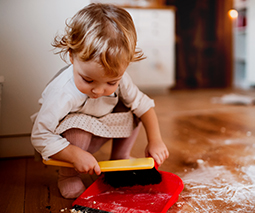How to respond to your little boy’s BIG emotions

Little boys can have some really big emotions.
While this isn’t necessarily news to parents, responding to his feelings without shutting him down can be tricky.
Little boys have big emotions
Early learning researcher and educator, Anthony Semann, says boys learn about emotions at a very young age.
“So you know, when they fall over we’re like, come on mate, get up, you’ll be fine,” says Anthony. “What they’re really learning is ‘don’t cry, it’s not okay’.”
“Some of it is okay and some of it I think leaves us watching on the sidelines going, is this really what we want our young boys to be as men?”
Listen to Anthony Semann on Feed Play Love:
How to respond to your boy’s emotions
Having empathy for a crying child is essential, but Anthony says there’s a better way to respond: attunement.
“Empathy is, ‘I see the world in the way that you see it’. Attunement is, ‘I feel the world in the way that you feel it,’” explains Anthony.
Although crying over broken Weet-Bix might sound silly to you, to a little boy who is experiencing emotions he’s never felt before, it can be A LOT!

When parents see young boys cry, they should put aside their empathy and regardless of the cause of the tears, acknowledge that he’s in pain.
“There is absolutely pain. It’s not for me to judge where that pain is coming from or whether it’s worthwhile,” Anthony adds.
“So attunement means we enter that space with that child. We look them in the eye, and we say, ‘This must be really sad for you.’ Just kind of connect with that child’s pain because that’s all the child is asking.
“We can’t rush to a solution because really the solution, in the long term, is ‘let’s self-regulate’.”
“It’s much easier to talk about it when they’re not crying”
Yes, talking about emotions and how to handle them is important, but as the saying goes, there’s a time and a place.
Luckily, Anthony says kids have pretty good memories and are capable of recalling what happened at a later time.
“Tomorrow when we’re sitting down having our Weet-Bix again, and everything is calm, I would just sit with him say, ‘I was thinking about yesterday. You got really upset. Do you want to talk about it? Do you know that it’s likely going to happen again? How are we going to deal with it?’
“It’s much easier to talk about it when they’re not crying.”
The best way to teach boys about emotions
The sooner boys learn about ’emotional literacy’, the sooner they can start linking their emotions with language.
“There’s a lot to be said about emotional literacy,” says Anthony. “For some reason, we have turned the language of emotions for young boys into happy and sad.”
But as we know, our feelings are a lot more complicated than just happy and sad.
“There’s devastation, there’s anxiety, there’s fear, and I think if we can start talking to young boys and giving them greater emotional literacy, then they can start to link how they’re feeling with language we can connect with.”
“The best way to teach children emotional literacy is when you’re reading them a book, point to the photo or the picture and ask them, ‘how do you think this person is feeling?’,” explains Anthony. “Teach them to identify those feelings in books.”
For more on Anthony and the work he does you can visit his website Semann & Slattery.









